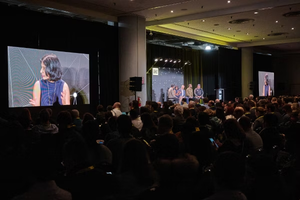IT Leaders Play Key Role in Helping Organizations Embrace Sustainability
AI uses more energy than conventional computing but can help curb climate change

Business leaders are waking up to the environmental impact of their technology, but also realizing that a sustainable approach to technology can have wider benefits for the whole organization. As analyst firm Gartner recently shared in its Top 10 Strategic Predictions for 2024, businesses should see that a growing shift towards efficient, circular and sustainable technology plays a key role in today’s success for businesses.
With increasing awareness of the energy demands of technologies such as AI, business leaders will increasingly embrace data-driven, sustainable and circular approaches to their technology investments. For leaders in the IT space, this will mean that they will be held responsible for the impact of technologies used across the organization and even in their supply chain. Gartner predicts that “by 2027, 25% of CIO’s compensation will be linked to their sustainable technology impact.”
Such a seismic shift in the importance of sustainable technology comes hand-in-hand with the growing awareness of sustainable technology’s benefits for the whole organization. According to Gartner’s head of research Chris Howard in a Keynote Session at the Gartner IT Symposium/Xpo, 74% of executives believe sustainability increases digital maturity, and 86% consider that it helps resilience. So how can business leaders take the first steps towards a more sustainable approach to technology?
A Balanced View
It’s crucial to take a broad view of an organization’s environmental impact, in terms of everything from packaging to shipping to the energy demands of data centers. In coming years, global regulations will require organizations to be more transparent about what they are doing to drive sustainability, and business leaders will need complete visibility.
The first and most important step for any organization is to move beyond “marking their own homework” on sustainability issues. Organizations should select scientifically-backed and globally-recognized organizations to partner with if they are serious about driving long-term sustainability gains.
The Science Based Targets initiative offers a science-backed way for organizations to drive toward net zero goals with its Net-Zero Standard. For example, Lenovo has partnered up with SBTi for its Net Zero goals, aiming to reduce Scope 1 and 2 emissions by half by 2030 and reduce emissions in the value chain by 25% by the same date.
Technology itself can play an important part in helping business leaders take an overview of their environmental impact. Lenovo’s “Data for Humanity” research report found that most business leaders believe data can help organizations play their part in the battle against climate change. Choosing the right software can mean business leaders can cut the environmental impact of their IT estate, such as by taking control of the number of end-user devices and using servers more efficiently.
Embracing technologies such as AI requires exactly this balanced view. AI uses much more energy than conventional computing, according to the International Energy Agency. A recent study showed that creating a single image with generative AI uses a similar amount of energy as that needed to fully charge a smartphone, according to the Allen Institute for AI.
But around the world, AI will also be key to driving cutting-edge research into how to curb climate change. Business leaders must take a balanced view of the broader impact of technology. Video calling can help to improve an organization’s carbon footprint by reducing the need for travel, for example, and technologies such as edge computing will be key to curbing carbon emissions on city streets, as demonstrated in one Lenovo project in Barcelona.
Circular Approaches
For business leaders, one of the most crucial issues to deal with is how to move beyond the old, wasteful ‘make, use, destroy’ cycle when it comes to technology. Electronic waste or ‘e-waste’ is now the fastest-growing waste stream in the world, with 50 million tonnes produced every year, more than the weight of every commercial airliner that has ever flown. Just 44% of this is recycled, according to the World Economic Forum.
Embracing the circular economy and moving to a “design, use, return” approach to IT products can drive big results. Most organizations in today’s business world are still at the start of this journey, recycling less than a tenth of IT hardware, according to recent research. There are now a huge range of ways to recycle or reuse technology products, from recycling and reusing to options such as waste-to-energy scrappage. Business leaders can engage with services like Lenovo’s Asset Recovery Services to ensure IT products are never simply thrown away, and instead generate value for the business after their working life.
A Greener Data Center
The electricity demands of data centers are enormous, amounting to up to 1.5% of electricity consumption worldwide, according to the International Energy Agency. Business leaders need to engage with this issue proactively, paying attention to everything from the mix of energy used to power data centers to how servers are shipped. In shipping, everything from sustainable fuels to reducing packaging by shipping servers in the rack can help.
How data centers are cooled is also an important issue. Technologies such as Lenovo’s Neptune liquid cooling technology can help to curb the demands of data centers. Older air-cooling technologies are becoming increasingly expensive, and are struggling to keep up with modern workloads, as CPUs and GPUs get hotter every year. Water is better at transferring heat than air, and liquid-cooling technologies will help drive the future of sustainable computing, including the next generation of supercomputers that will wrangle with humanity’s biggest challenges including climate change itself.
A Cleaner Future
With IT leaders increasingly shouldering responsibility for many sustainability issues, businesses need clarity and policies in place around every part of their organization. A top-down view across the whole organization and its use of technology is essential, from choosing vendors who offer nearby manufacturing and sustainable shipping and packaging, to asset recovery services to ensure devices never end up in skips at the end of their lives.
Companies must take a broad view of sustainability across the whole value chain, from logistics to services. The key is to first understand the issues, then partner with science-backed organizations to drive results, and take action to build a cleaner, data-driven future.
About the Author(s)
You May Also Like





.jpg?width=300&auto=webp&quality=80&disable=upscale)
.jpg?width=300&auto=webp&quality=80&disable=upscale)
.jpg?width=300&auto=webp&quality=80&disable=upscale)

.jpg?width=300&auto=webp&quality=80&disable=upscale)